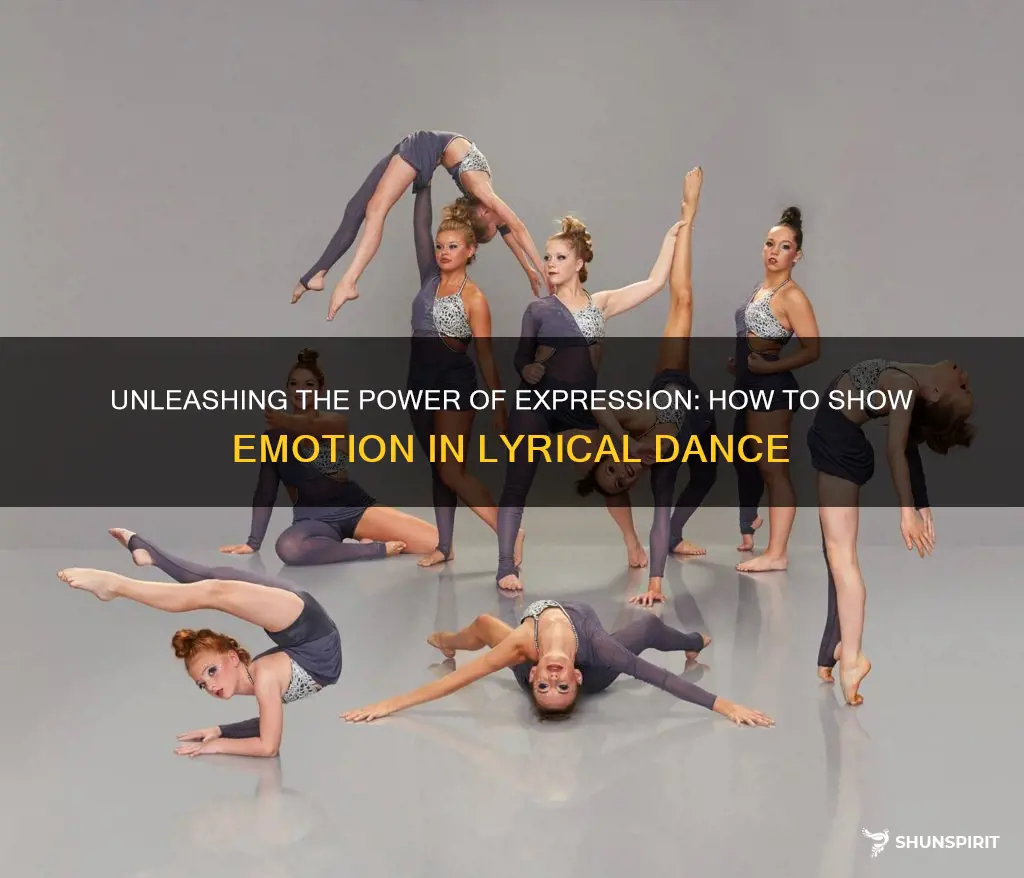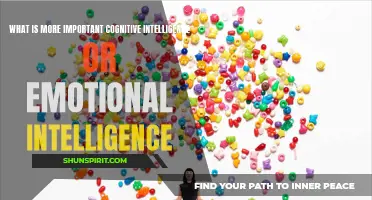
Lyrical dance is known for its ability to convey deep emotions through movement and expression. As dancers gracefully glide and contort their bodies to the music, they create a visual narrative that can tug on heartstrings and transport audiences into a world of raw emotion. But how exactly do dancers achieve this level of emotional connection? In this article, we will explore the various techniques and strategies for effectively showing emotion in lyrical dance, from understanding the music and lyrics to incorporating dynamic movements and facial expressions. So, if you're ready to dive deeper into the world of lyrical dance and unlock the power of emotional storytelling, strap on your dancing shoes and let's begin!
| Characteristics | Values |
|---|---|
| Facial expressions | Expressing various emotions through the face, such as joy, sorrow, anger, etc. |
| Body movements | Flowing and graceful movements with fluid transitions between poses and gestures. |
| Use of levels | Incorporating movement at different levels, including high, medium, and low levels. |
| Use of space | Utilizing the entire stage space, including the front, back, sides, and diagonals. |
| dynamics | Varying the intensity and energy of movements, including slow and fast motions. |
| Use of props | Incorporating props to enhance the emotional storytelling, such as scarves or chairs. |
| Gestures | Using hand and arm gestures to convey emotions and enhance the storytelling. |
| Timing | Syncing movement with music and lyrics to create a cohesive and impactful performance. |
| Transitions | Smoothly transitioning between different movements and poses to create a seamless flow. |
| Costume and makeup | Choosing costumes and makeup that reflect the intended emotion and enhance the performance. |
What You'll Learn

Importance of Emotion in Lyrical Dance
Lyrical dance is a beautiful form of expression that combines the grace and fluidity of ballet with the emotional depth of contemporary dance. One of the key elements that sets lyrical dance apart from other dance styles is the importance of emotion. In lyrical dance, connecting with the audience and enhancing the storytelling element are crucial in order to create a powerful and memorable performance.
Connecting with the audience is essential in lyrical dance. It is what brings the performance to life and allows the audience to fully engage and experience the emotions conveyed through movement. To effectively connect with the audience, dancers must first connect with themselves. This means understanding the emotions being portrayed in the dance and tapping into their own personal experiences and feelings. By connecting with their own emotions, dancers are able to convey the intended message more authentically and deeply.
To enhance the storytelling element in lyrical dance, dancers must go beyond the technical execution of steps and movements. They must understand the narrative or concept behind the dance and bring it to life through their emotional portrayal. This involves focusing on the character or story that is being portrayed and understanding the emotions and motivations that drive it.
One way to enhance the storytelling element is through the use of facial expressions and body language. Dancers should constantly be aware of their facial expressions and ensure that they are aligned with the emotions they are trying to convey. Furthermore, body language should be used to enhance the movements and bring out the intended emotions. For example, a light and flowing movement can convey a sense of happiness or freedom, while a heavy and grounded movement can express sadness or despair. By consciously using facial expressions and body language, dancers can create a more believable and compelling performance.
In addition to facial expressions and body language, dancers can also use their costumes and props to enhance the storytelling element. Costumes can help set the mood and atmosphere of the dance, while props can be used to further emphasize the emotions being portrayed. For example, a dancer holding a white flag can symbolize surrender or peace, while a dancer wearing a flowing dress can evoke a sense of elegance and femininity. By carefully selecting and utilizing costumes and props, dancers can add another layer of depth to their performance.
Lastly, musicality plays a big role in enhancing the storytelling element in lyrical dance. Dancers must not only be technically proficient in their movements, but also in their ability to interpret and connect with the music. They should be able to feel the music and let it guide their movements, allowing the emotions of the music to flow through their bodies. By fully immersing themselves in the music, dancers can create a seamless and harmonious blend of movement and emotion.
In conclusion, the importance of emotion in lyrical dance cannot be overstated. Connecting with the audience and enhancing the storytelling element are essential in order to create a captivating and memorable performance. By connecting with themselves, using facial expressions and body language, utilizing costumes and props, and immersing themselves in the music, dancers can bring their performances to life and leave a lasting impact on their audience. So, next time you hit the dance floor, remember to feel the emotions and let them guide your movements.
Unmasking Emotions: How to Portray Feelings in a Masked Character
You may want to see also

Techniques for Expressing Emotion in Lyrical Dance
Lyrical dance is a beautiful form of artistic expression that combines elements of ballet, jazz, and contemporary dance. One of the key aspects of lyrical dance is its ability to convey emotions through movement. In this article, we will delve into three essential techniques that dancers can employ to fully embody and convey emotions in their lyrical dance performances: body language and facial expressions, dynamics and musicality, and the use of breath and focus.
Body Language and Facial Expressions:
A. Connect emotionally with the movement: Begin by establishing a deep emotional connection to the piece's theme or story. This connection will help you express authentic emotions through your body language and facial expressions. Try to understand the emotional journey of the choreography and visualize the story in your mind.
B. Mirror the emotions with your body: Once you have established the emotional connection, imagine your entire body as a canvas for your emotions. Begin by experimenting with various physical gestures and positions that express the specific emotions you want to convey. For example, opening your arms wide may represent joy, while sinking to the ground can convey sadness or despair.
C. Communicate through your face: Your face plays a vital role in expressing emotions in lyrical dance. Practice different facial expressions that reflect the emotions of the choreography, such as happiness, sorrow, anger, or longing. Utilize your eyes, eyebrows, and mouth to convey specific emotions, and remember to maintain eye contact with the audience to create a powerful connection.
Dynamics and Musicality:
A. Analyze the music: Before diving into the choreography, carefully listen to the music, paying attention to its tone, tempo, and overall mood. Identify the underlying emotions the music evokes and take note of any instrumental breaks or changes in rhythm. Understanding the music will help you infuse your movements with the appropriate dynamics and enhance your emotional expression.
B. Explore variations in movement quality: Dynamics play a crucial role in portraying emotions. Experiment with varying levels of intensity, speed, and flow in your movements to match the energy and emotions of the music and choreography. For instance, soft, fluid movements can depict tenderness, while bold, sharp movements can convey power or anger.
C. Extend your lines for emphasis: Lyrical dance often emphasizes elongated lines to create a visually striking effect. Use extensions and lines to accentuate emotional moments in the choreography. Stretch your limbs to their fullest potential, maintaining control and grace throughout your movements. This elongation will further intensify the emotional impact of your performance.
Use of Breath and Focus:
A. Harness the power of breath: Breathing plays a vital role in deepening your emotional connection and enhancing the fluidity of your movements. Practice incorporating intentional breaths into your dancing, allowing the flow of air to guide your movements. Inhale deeply to gather energy and exhale with controlled release to intensify emotional moments.
B. Focus your attention: Cultivating a focused mind is essential for delivering a convincing and emotionally charged lyrical dance performance. Concentrate on the present moment, blocking out distractions, and surrendering yourself to the emotions of the dance. Maintain an unwavering focus, and let your concentration guide your movements and expressions.
Mastering the techniques of expressing emotions in lyrical dance requires a deep understanding and practice of body language and facial expressions, dynamics and musicality, as well as the use of breath and focus. By connecting with the choreography emotionally, exploring variations in movement quality, and employing intentional breaths and focused attention, dancers can create powerful and captivating performances that leave a lasting impact on both themselves and the audience. So, embrace your emotions, unleash your creativity, and let your lyrical dance beautifully tell the stories of your heart.
The Psychological Impact of Emotional Abuse on Men and Its Connection to Sexual Orientation
You may want to see also

Tips for Portraying Emotion in Lyrical Dance
Lyrical dance is an expressive form of movement that combines ballet and jazz techniques with emotional storytelling. Through graceful movements, dancers can convey a range of emotions, from joy and happiness to sadness and heartbreak. If you're looking to enhance your ability to portray emotions in lyrical dance, here are some tips to help you become a more emotive and compelling dancer.
Understand the lyrics and music:
One of the first steps in portraying emotion in lyrical dance is to thoroughly understand the lyrics and music of the piece you are performing to. Read the lyrics and listen to the music attentively, paying close attention to the mood and message conveyed. Take note of the nuances, dynamics, and rhythms that can evoke certain emotions. Familiarize yourself with the story and meaning behind the lyrics to have a deeper understanding of the emotional context you need to convey.
Immersion and visualization techniques:
To effectively portray emotions in lyrical dance, it's crucial to immerse yourself in the character and story you're portraying. Before you start dancing, take a moment to close your eyes and visualize the scene and the emotions you want to convey. Picture yourself as the character and try to empathize with the emotions they are experiencing. Imagine the texture, color, and ambiance of the environment you're performing in. By using visualization techniques, you can create a more authentic emotional connection and bring depth to your performance.
Connect with your personal experiences:
Finding a personal connection to the theme or emotion of the lyrical dance piece can significantly enhance your performance. Reflect on your own life experiences and identify moments when you felt a similar emotion to what you're trying to portray. Consider the physical sensations, thoughts, and expressions associated with that emotion. By tapping into your own emotions, you can bring an authentic and relatable quality to your dance, making it more powerful and resonant with your audience.
Use your body to express emotion:
In lyrical dance, your body becomes your instrument for expressing emotions. Focus on utilizing your body movements, facial expressions, and gestures to accurately convey the desired emotion. Experiment with different ways of expressing emotions through your body, such as elongated lines, fluid movements, and dynamic shifts in energy. Pay attention to your facial expressions, as they can greatly enhance the emotion you're portraying. Practice conveying different emotions in front of a mirror, observing how your body language changes to reflect each emotion.
Invest in technical proficiency:
While emotion is a vital aspect of lyrical dance, it's essential not to neglect the technical proficiency required to execute the movements. Strong technique provides a solid foundation for portraying emotions effectively. Take regular technique classes and spend time refining your dance skills. Strengthen your core, improve your flexibility, and work on your balance and control. When you have a strong technical foundation, you'll be able to execute movements with ease, allowing your focus to shift more towards the emotional aspects of your performance.
In conclusion, portraying emotion in lyrical dance is a skill that can be developed through understanding the lyrics and music, employing visualization techniques, finding personal connections, using your body effectively, and investing in technical proficiency. By incorporating these tips into your practice, you can bring depth and authenticity to your performances, captivating your audience and touching their hearts with your emotional storytelling abilities.
The Impact of Childhood Abuse on Adult Emotional Immaturity: Exploring the Lasting Effects
You may want to see also

Ongoing Practice and Development of Emotional Expression
Emotional expression is a fundamental aspect of dance and can greatly enhance the impact of a performance. Working with a dance instructor or coach is essential for ongoing practice and development in this area. These professionals can provide valuable guidance and support as you explore different styles and themes, and they can help you embrace vulnerability and self-expression in your dancing. Here are some tips for making the most of your time with a dance instructor or coach:
Choose the Right Instructor or Coach
Finding the right dance instructor or coach who resonates with your goals and style is crucial. Look for someone who has expertise in the style of dance you are interested in and who has a deep understanding of emotional expression in dance. It is also important to select an instructor or coach who creates a positive and supportive learning environment.
Communicate Your Goals and Aspirations
When working with a dance instructor or coach, it is important to clearly communicate your goals and aspirations. Make sure your instructor understands what you want to achieve in terms of emotional expression. This will help them tailor their guidance and feedback to your specific needs, giving you a better chance of achieving your desired outcomes.
Explore Different Styles and Themes
To develop your emotional expression, it is essential to explore different styles and themes in dance. Working with a dance instructor or coach can expose you to a wide variety of movements, techniques, and choreographic styles. Embrace this opportunity to experiment and step out of your comfort zone. Trying on different styles will expand your range of emotional expression and help you discover new ways to convey feelings through movement.
Embrace Vulnerability and Self-Expression
Vulnerability is a key element in emotional expression. To fully express yourself through dance, you must be willing to let your guard down and open yourself up to the emotions and experiences that the movement represents. Your dance instructor or coach can help you create a safe and supportive space where you feel comfortable exploring and expressing your emotions. Take advantage of this and allow yourself to be vulnerable, knowing that it is a crucial part of the creative process.
Practice, Practice, Practice
Like any other skill, practicing regularly is essential for improving your emotional expression in dance. Take the lessons and feedback from your dance instructor or coach and incorporate them into your regular practice routine. Set aside dedicated time each week to focus on your emotional connection to the movement and refine your ability to convey a range of emotions effectively.
In conclusion, working with a dance instructor or coach is invaluable for the ongoing practice and development of emotional expression in dance. By choosing the right instructor, communicating your goals, exploring different styles and themes, embracing vulnerability, and practicing consistently, you can take your emotional expression in dance to new heights. So, find a trusted instructor or coach and embark on an enriching journey towards becoming a more expressive dancer.
Why Do Emotional Abusive Parents Often Say "I Love You"?
You may want to see also







